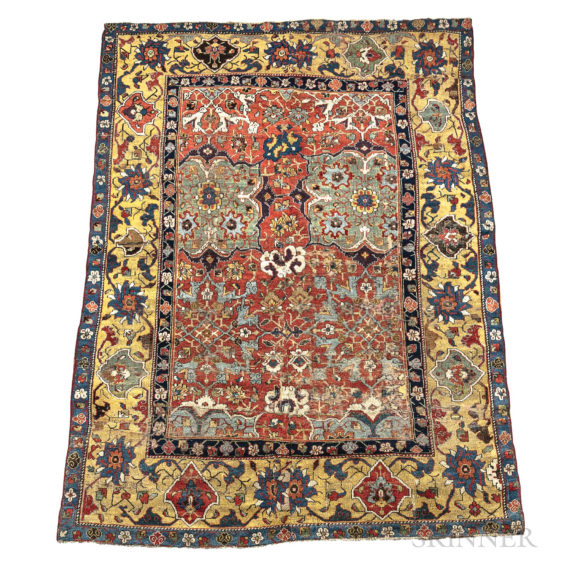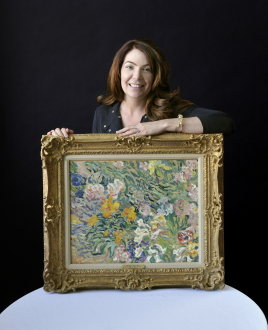People have always treasured the idea and reality of gardens. They are among the most beloved and universal motifs in art and literature — the Garden of Eden; the Hanging Gardens of Babylon; the Garden of Paradise in the Koran; the Garden of Hesperides, named for the nymphs who tended its golden apples in Greek mythology. Whether real or symbolic, gardens lift our spirits with images of beauty, growth and renewal.
Real-life gardens blossom, fade and die. But fortunately there are gardens that are always in bloom — the glorious flowers and foliage that have brightened Oriental carpets and other textiles for hundreds of years. Skinner Inc.’s recent sale of Jim Dixon’s legendary collection — the first in a series of Skinner auctions representing the collection — proves the perennial appeal of these magic carpets.
Dixon was a landscape designer by profession, a scholar of classical studies and a lifelong collector of rugs of historical and aesthetic importance. His collection was notably broad and deep. Benjamin Mini, Skinner’s director of rugs and carpets, notes that “Dixon sought out the rarest examples, pieces which pushed boundaries and are often difficult to classify. The collection is also remarkable for the artistry of its pieces. Dixon chose beautiful pieces to collect, not merely rare ones.”
His encyclopedic botanical knowledge informed his love of artistic representations of plants and flowers in textiles. Blossoms, vines and trees, often in highly stylized form, are constant features in both Middle Eastern and Chinese rugs. Motifs like roses, daisies, palmettes and lotuses are represented in rich variety in Dixon’s extensive collection.
Dixon was not only a textile connoisseur; he was a carpet sleuth, fascinated with “mystery rugs” of unknown or uncertain origin. He also emphasized age, focusing on rugs made before 1860 and therefore pieces that employed natural dye stuffs rather than the synthetics that have predominated since the later-19th century.
Another distinctive aspect of Dixon’s collecting philosophy was his confident acquisition of worn and tattered examples that might be overlooked by less knowledgeable buyers. More than one visitor to his self-designed California home and gallery expressed mystification — and disdain — at some of the battered pieces on prominent display. But beauty, artistry and rarity always trumped condition as far as Dixon was concerned.
A newspaper article referred to him as “probably the most accomplished fragment collector ever.” Many of Dixon’s remnants were unique and uniquely valuable to scholars. Some of his prized pieces date from the 16th century. Naturally the great age of many of the textiles Dixon collected — rugs were, after all, items in daily use underfoot —meant that they are sometimes in poor or partial condition.
For most collectors, the acquisition of their particular objects of desire starts out as a hobby, a casual interest. For a few, collecting becomes a passion, a pursuit that involves ever-increasing knowledge and the determination to acquire the best of the best. Dixon was such a collector, largely self-taught and endlessly curious. He was always willing to share his knowledge. The Skinner sale of the Hesperides collection now allows the sharing of the textile treasures he accumulated in a half-century of searching for the rarest and most beautiful woven gardens.
For more, contact Katie at kwhittle@skinnerinc.com or 212-787-1114.


